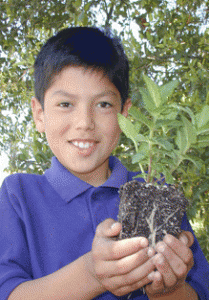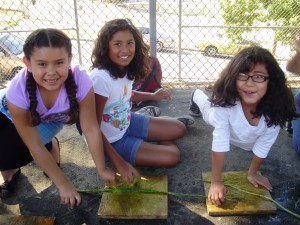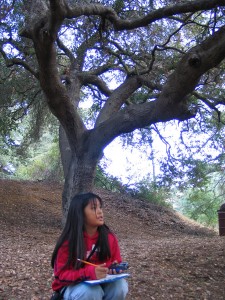A couple of weeks back a teacher friend reminded us of a “rambling rant” that we sent her a year or so ago, after the release of the Next Generation Science Standards. With the public comment period on the California Department of Education’s implementation plan of those standards closing today, it seems worth revisiting and re-sharing these thoughts (now sanitized for public consumption).
As is it is with all things, if you hold onto it long enough, it comes back in fashion.
So it goes with the holisitic view of teaching, learning and thinking that Wildwoods has fostered and championed for 15 years. Long have we banged the drum of systems thinking as a framework to understand universal principals that can be applied across the scientific disciplines (including social), particularly in our flagship program, Full Circle.
 And now we see in the second of the Next Generation Science Standards’ “3-dimensions,” a focus on “systems” (number four on the list of Crosscutting Concepts) which the Next Gen authors define as “concepts [that] have application across all domains of science [and] as such, they are a way of linking the different domains of science.”
And now we see in the second of the Next Generation Science Standards’ “3-dimensions,” a focus on “systems” (number four on the list of Crosscutting Concepts) which the Next Gen authors define as “concepts [that] have application across all domains of science [and] as such, they are a way of linking the different domains of science.”
But even more importantly, we see that the other items on the list of Crosscutting Concepts are ideas that Wildwoods (and others) has long defined in our curriculum as “systems principles,” those relationships, connections and operations that are found universally. But by whatever name you call them, these Crosscutting Concepts are manifested in systems operation: pattern, cause and effect, energy flow, adaptation, scale, diversity and interdependence.
As these principles or concepts are identified in one system, they can serve as a marker to help students analyze the structure and operation of another. Helping students attain this perspective cultivates their critical thinking skills, applying information from one experience to another situation, problem or challenge.
 So, while we celebrate the Next Gen’s focus on these core concepts of scientific principles, we would also add another step: Interaction with nature.
So, while we celebrate the Next Gen’s focus on these core concepts of scientific principles, we would also add another step: Interaction with nature.
We believe, as we have from our beginning, that a personal, hands-on interaction with nature is essential to the healthy development of the whole child. We believe that regular exposure to natural phenomena allows children the opportunity to observe scientific principles over time and thus develop an inherent understanding of these principles: gravity, flow, balance, cycles, etc.
But as the shift in US demographics over the last 50 years shows an increasing and accelerated move from rural areas to more densely-populated urban centers and we have become less of an agrarian society, those opportunities for observation no longer exist for the increasing majority of our population. Our contention is that our society needs to make a conscious effort to accommodate that lack of nature exposure (or, as eloquently coined by Last Child in the Woods author Richard Louv, “nature deficiency disorder”).
 Years ago we attended a conference where Louv asked the room how many of us as a children had tried to dam a creek. When most of the hands in the room shot up, he responded (and we paraphrase), “That experience taught you more about physics than an entire week in a classroom.”
Years ago we attended a conference where Louv asked the room how many of us as a children had tried to dam a creek. When most of the hands in the room shot up, he responded (and we paraphrase), “That experience taught you more about physics than an entire week in a classroom.”
At Wildwoods, we believe that it is just such experiences that form the foundations of students’ understanding about science and engineering, whether it’s controlling the flow of water, information or electrons.
That’s why the most important aspects of our program are hands-on learning experiences. Even games (as opposed to scientific experiments or data collection) that illustrate scientific principles give students the opportunity to develop a kinetic understanding of that principle (e.g. the Deadly Links game from “Project Wild,” illustrating the principle of bio-accumulation as well as the principle of nested systems).
However, for all the forethought and planning that goes into cre ating quality programs with engaging activities, sometimes our most important job is to just get out of the way and allow students to have their own moment and begin to develop their own personal relationship with nature. Thus, we try to include some “unstructured” time for individual exploration. It is those discoveries that we make ourselves that will stay with us for a lifetime.
ating quality programs with engaging activities, sometimes our most important job is to just get out of the way and allow students to have their own moment and begin to develop their own personal relationship with nature. Thus, we try to include some “unstructured” time for individual exploration. It is those discoveries that we make ourselves that will stay with us for a lifetime.
And as Louv illustrated with his question, those discoveries of such an elemental principle of physics or science have academic and practical applications that would fill volumes and span hundreds of thousands (if not more) different types of professions.
And as David Orr is famously quoted as saying “All education is environmental education.” Without context, these ideas, concepts and principles that we teach are abstract; disconnected from each other and from us. And (to paraphrase Orr), also disconnected from reality.
For these principles to have relevance in students lives and in the world in which they live, they need the foundation of that context that is nature. Let’s give them that context.
From the Next Generation Science Standards
Dimension 2: Crosscutting Concepts
Crosscutting concepts have application across all domains of science. As such, they are a way of linking the different domains of science. They include: Patterns, similarity, and diversity; Cause and effect; Scale, proportion and quantity; Systems and system models; Energy and matter; Structure and function; Stability and change. The Framework emphasizes that these concepts need to be made explicit for students because they provide an organizational schema for interrelating knowledge from various science fields into a coherent and scientifically-based view of the world.
SEVEN CROSSCUTTING CONCEPTS OF THE FRAMEWORK
The committee identified seven crosscutting scientific and engineering concepts:
1. Patterns. Observed patterns of forms and events guide organization and classification, and they prompt questions about relationships and the factors that influence them.
2. Cause and effect: Mechanism and explanation. Events have causes, sometimes simple, sometimes multifaceted. A major activity of science is investigating and explaining causal relationships and the mechanisms by which they are mediated. Such mechanisms can then be tested across given contexts and used to predict and explain events in new contexts.
3. Scale, proportion, and quantity. In considering phenomena, it is critical to recognize what is relevant at different measures of size, time, and energy and to recognize how changes in scale, proportion, or quantity affect a system’s structure or performance.
4. Systems and system models. Defining the system under study—specifying its boundaries and making explicit a model of that system—provides tools for understanding and testing ideas that are applicable throughout science and engineering.
5. Energy and matter: Flows, cycles, and conservation. Tracking fluxes of energy and matter into, out of, and within systems helps one understand the systems’ possibilities and limitations.
6. Structure and function. The way in which an object or living thing is shaped and its substructure determine many of its properties and functions.
7. Stability and change. For natural and built systems alike, conditions of stability and determinants of rates of change or evolution of a system are critical elements of study.